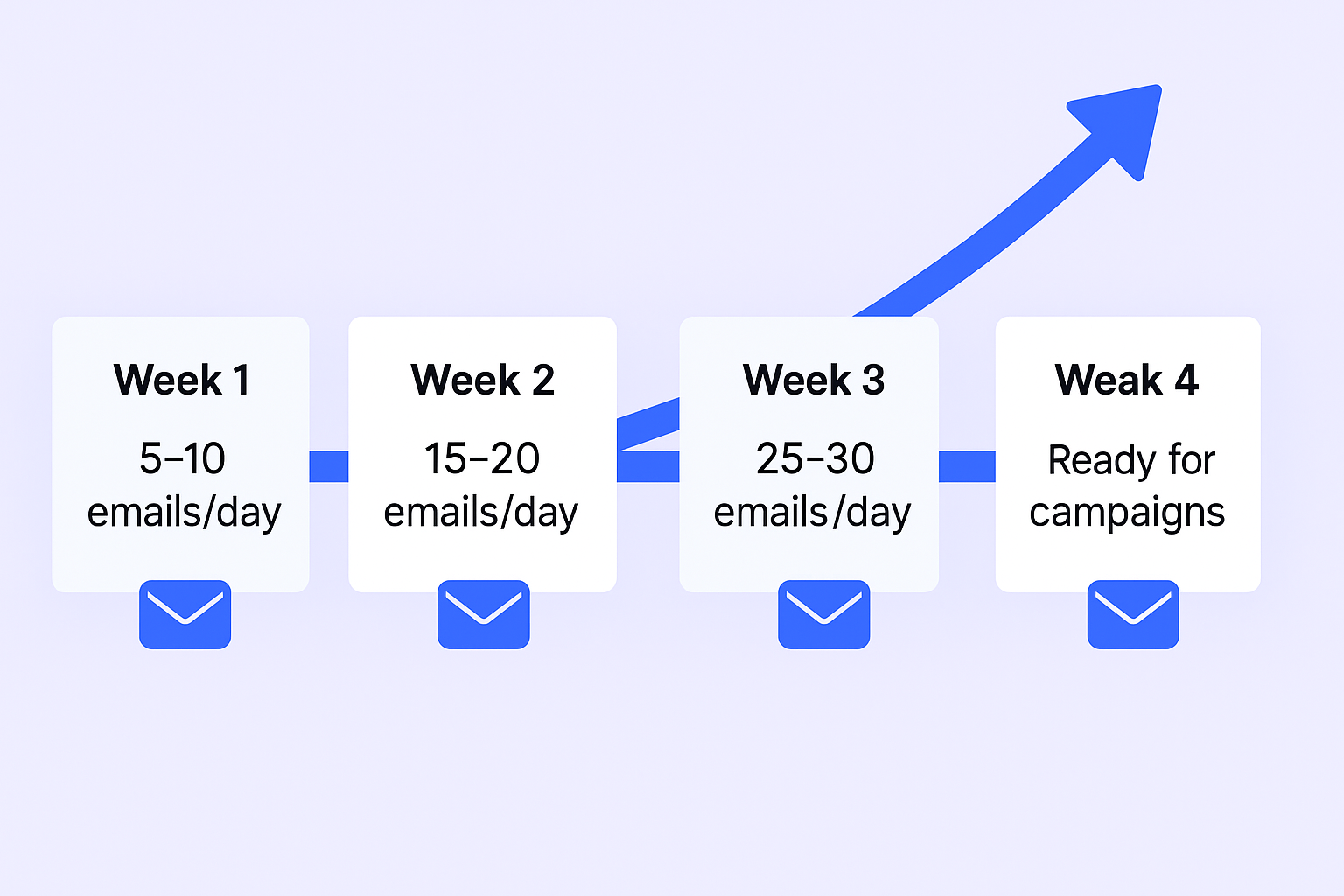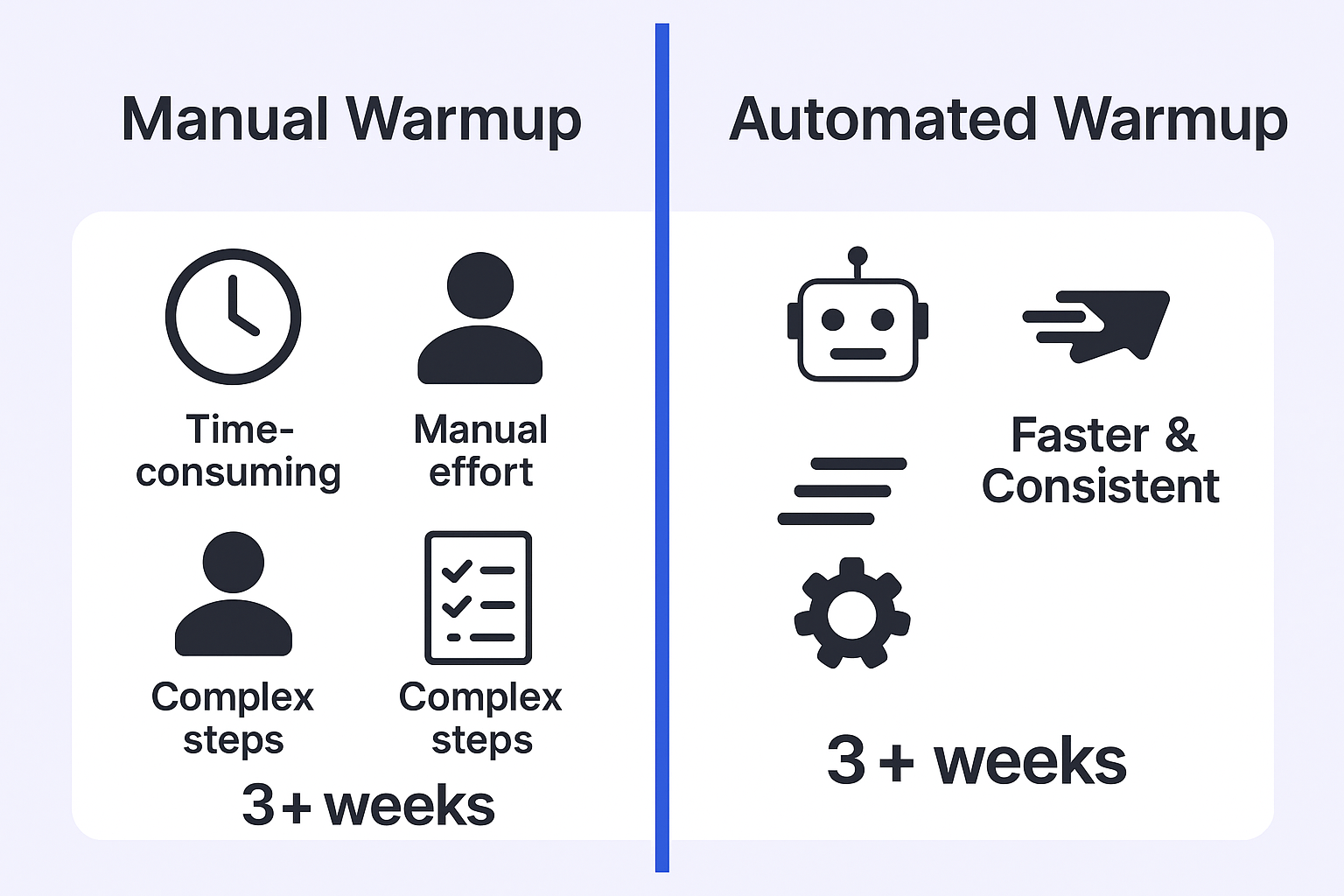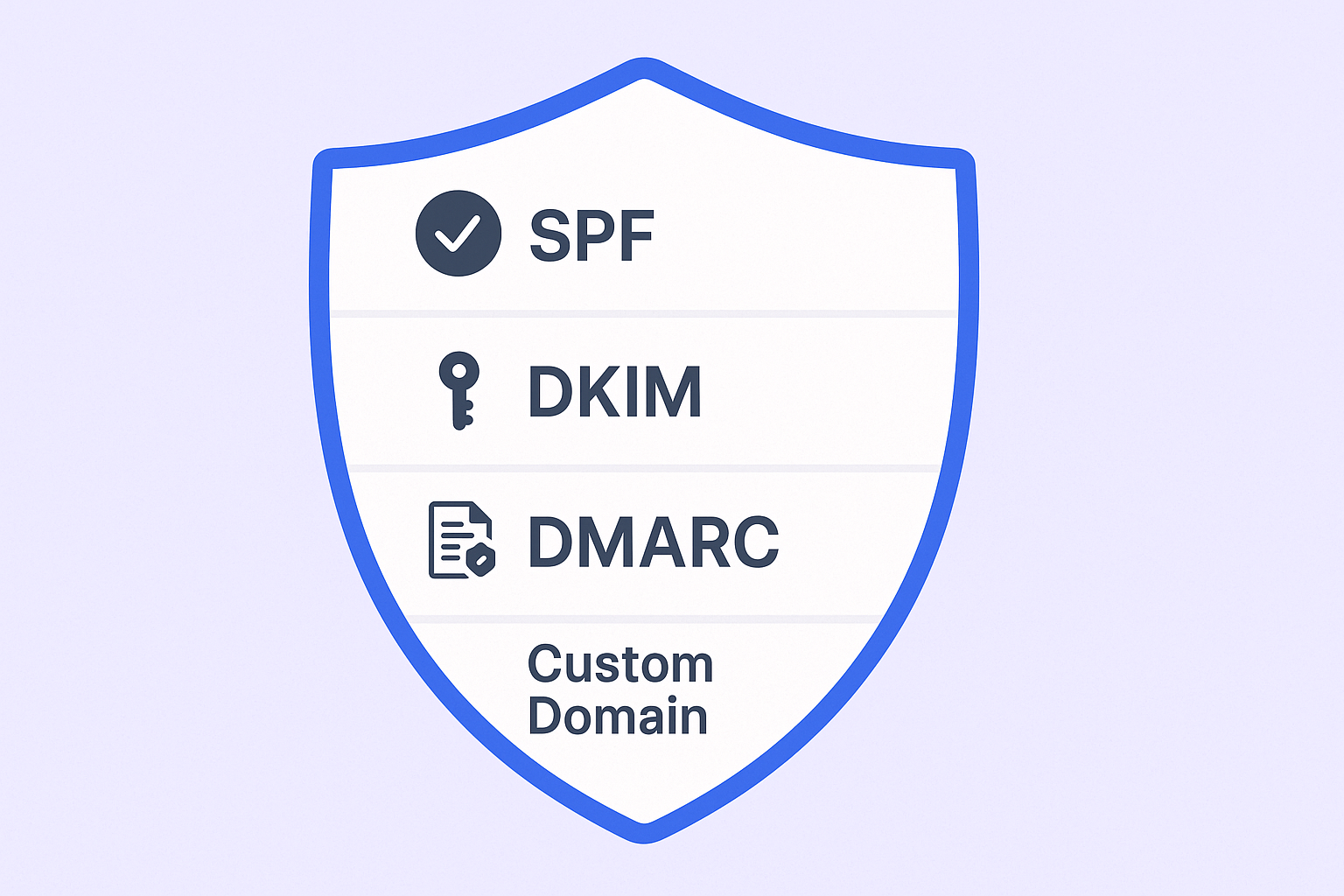- blog
- Cold Emailing
- How to Warm Up Cold Email Address for Maximum Deliverability

Table of Contents
If you’re a BDR or AE, your inbox is your battlefield. Landing those crucial cold email outreach messages in the primary inbox, rather than the dreaded spam folder, can make or break your day, your week, and your quota. That’s where email warmup comes in.
Think of it like this: you wouldn’t run a marathon without training, right? The same goes for your email account. You can’t just start blasting hundreds of emails from a new address and expect stellar results. It needs a little prep work, a “warm-up,” to build trust and ensure your messages actually get seen.
Ready to make your cold email campaigns shine? Let’s dive in.
What Is Email Warmup?
Email warmup is the essential process of gradually increasing your email sending activity from a new or dormant email account to build a positive reputation with email service providers (ESPs) like Gmail and Outlook. It’s like teaching a new email address how to be a good citizen in the digital world.
When you create a new email account, it starts with a neutral reputation. ESPs impose daily sending limits on new accounts. For example, a G Suite account might offer 2,000 emails per day, but a fresh account will initially have a much smaller limit. The warm-up process involves sending a small number of emails initially and then progressively increasing the volume each day.
Imagine it as a friendly handshake before your sales pitch.
You start slow, sending a few emails, getting replies, and over time, your reputation grows. This mimics normal, healthy, human-like behavior, which is exactly what inboxes want to see.
ESPs operate on a “trust economy.” They’re gatekeepers, protecting their users from unwanted spam. A new email address is inherently viewed with suspicion because spammers frequently use fresh accounts to bypass filters. Therefore, the warm-up process isn’t merely a technical configuration; it’s a strategic act of demonstrating trustworthy behavior through consistent, human-like interactions.
Why Is Email Warm-Up Important?
For BDRs and AEs, your emails are your lifeline. If they don’t land in the inbox, your cold email outreach efforts are wasted. Email warmup isn’t just a recommendation; it’s a critical first move for successful outreach.
Build Reputation
Your sender reputation is a crucial score that identifies you as a trusted—or mistrusted—sender. ESPs like Gmail and Outlook check this score before allowing your emails to pass through. A new email account begins with a neutral reputation.
Every action you and your recipients take—sending, receiving, opening, replying, or marking as spam—is evaluated and used to determine this score. Positive, normal activities contribute to a good reputation, while sending a large volume of ignored or spam-marked emails will significantly lower it.
Only about 25% of professionals feel confident about their understanding of sender reputation, indicating a significant knowledge gap that can inadvertently harm email deliverability. This lack of understanding can lead many sales professionals to unknowingly damage their outreach potential.
Your reputation is intrinsically linked to your IP address and domain. It’s influenced by your sending history, the number of spam complaints received, instances of hitting spam traps, and the proper configuration of authentication protocols such as SPF, DKIM, and DMARC.
Avoid Spam Filters/Folders
Email service providers employ sophisticated algorithms to determine whether an email should land in the primary inbox, the spam folder, or be blocked entirely. If you bypass the warm-up process and immediately begin sending a large volume of emails, your sender reputation will take a significant hit, and your messages will likely be discarded before they even reach your audience.
A staggering 49% of all emails sent each day are spam, totaling approximately 162 billion spam emails daily. This high volume necessitates strict filtering mechanisms.
The consequences of skipping email warmup are severe:
- Your emails may go directly to spam folders
- Even if not outright spam, your messages might be pushed to promotions tabs or deprioritized by ESPs
- You may experience higher bounce rates
- Ultimately, ISPs may block your emails altogether
Improve Email Deliverability
The primary objective of email warmup is to ensure your emails successfully reach the recipient’s primary inbox, rather than landing in the spam or promotions tab. When an email is sent, ESPs and ISPs first examine your email address history and user engagement before deciding on delivery.
While average email deliverability is around 81%, meaning 19% of emails are either missing or caught by spam filters, the specific metrics for cold emails can be even more demanding. Average open rates for cold email outreach have been reported between 40% and 60%, with response rates between 1% and 5%. However, more recent data indicates a decline, with open rates dropping from 36% in 2023 to 27.7% in 2024, and response rates around 5.1%.
For B2B cold email campaigns, a 15-25% open rate is now considered acceptable, with a 5%+ reply rate being “good” and 10%+ being “excellent.”
💡Eliminate Email Warmup Complexity
Our LinkedIn outbound system transforms prospects into eager contacts who anticipate your messages
How To Manually Warm Up Your Email?
Warming up your email account manually requires consistent effort and patience. This process typically takes a minimum of three weeks to establish a positive sender reputation.
Account Setup
Establishing a solid foundation for your email account is the first critical step:
Get a Professional Domain: Always use a business domain (e.g., yourname@yourcompany.com) instead of generic public email address providers like Gmail or Yahoo. A custom domain significantly boosts your email’s credibility and visibility.
Set up G Suite (or similar): Configure a professional email service like G Suite for your domain. This functions like Gmail but is tailored for businesses.
Link to a Website: During the setup process, ensure your email address is linked to a website. This connection enhances its credibility in the eyes of ESPs.
Domain Reputation and Waiting Period: New domains start with a neutral reputation. Building a positive or negative reputation takes time and directly impacts email deliverability. If you’re using a brand new domain specifically for cold email outreach, it’s highly recommended to wait at least 12 weeks before initiating any campaigns. However, for an existing domain that already has a strong reputation, you might be able to start campaigns in as little as 2 weeks.
Profile Picture & Signature: Enhance the authenticity of your email account by adding a profile picture (especially for Gmail accounts) and a detailed email signature. This signature should include your name, position, and contact information.
Domain Authentication
Domain authentication is a non-negotiable step to ensure your emails bypass spam filters and are delivered directly to the recipient’s inbox. Without proper authentication, your emails are far more likely to be flagged as suspicious, regardless of their content.
There are four key email authentication protocols:
SPF (Sender Policy Framework):
This is a DNS TXT record that explicitly lists the mail servers authorized to send emails on behalf of your domain. When a recipient’s email server receives an email from your domain, it checks your SPF record.
DKIM (DomainKeys Identified Mail): DKIM involves adding a digital signature to your outgoing emails. This signature is encrypted and uniquely linked to your domain. When an email server receives a message with a DKIM signature, it can verify that the email hasn’t been tampered with during transit.
DMARC (Domain-based Message Authentication, Reporting & Conformance): DMARC builds upon both SPF and DKIM by providing a policy for how email receivers should handle emails that fail either SPF or DKIM authentication.
Custom Domain: Using your own custom domain for sending emails significantly enhances credibility.
Setup Timing: It’s crucial that SPF and DKIM are authenticating messages for at least 48 hours before you proceed with setting up DMARC.
Send Individual Emails
Once your account is set up and authenticated, begin the actual warm-up by sending a low volume of individual emails. Start with 5-10 emails per day to friends, colleagues, and other known contacts who are highly likely to open and respond. Gradually increase this volume, adding a few emails each day until you reach approximately 30 emails per day.
Personalization: Your initial emails should be personalized and conversational. Avoid immediate sales pitches; instead, focus on casual conversations to build engagement and credibility.
Diversify Recipients: To build a positive reputation across a wide range of ESPs, send your warm-up emails to various services, including Yahoo, Outlook, iCloud, GoDaddy, Zoho, AOL, Exchange, and Yandex.
Encourage Engagement: Actively ask your recipients to open your messages, reply to them, and mark them as important. If an email inadvertently lands in their spam folder, ask them to move it to their inbox and mark it as safe.
Consistent Gaps: Maintain consistent, natural-looking gaps between emails, such as a 1-minute delay between each send. Distribute your sends throughout working hours rather than sending them all at once.
Subscribing to Newsletters
To further demonstrate active and legitimate email account usage, subscribe to at least 10-15 weekly newsletters from various reputable publications relevant to your industry, such as sales, marketing, or recruitment. Crucially, confirm each subscription from your inbox.
While sending emails builds your outbound reputation, subscribing to newsletters and confirming them builds your inbound engagement. This shows ESPs that your email address is an active, legitimate user, not merely a sender.
Maintaining Conversation Threads
For your email account to truly gain trust, it must foster two-way communication. Initiate conversations from your alternate email address (or a colleague’s) and then reply from your new warm email. This consistent engagement over a period of 8-12 weeks is crucial for establishing a strong reputation.
Perform A Test Campaign
After diligently following the manual warm-up steps and observing the recommended waiting periods—at least 12 weeks for a brand new domain or 2-3 weeks for a new email account on an existing domain—it’s time to prepare the content for your first cold email campaign.
Select 10 to 20 verified email addresses and launch an automated test campaign. The purpose of this test campaign is twofold: it helps you become familiar with your chosen cold email outreach tool, and it provides invaluable insights into how to avoid Google’s spam filters when crafting and sending your actual campaigns.
Crucially, for this test to be effective, recipients in your test campaign must reply to your emails, and you, in turn, must reply back. This two-way interaction demonstrates to Google and other ESPs that your business emails are relevant and engaging, rather than unsolicited spam.
🚀 Beyond Technical Email Solutions
LinkedIn relationship building achieves 40% response rates while cold emails struggle with deliverability
Email Warm-Up Service Using GrowMeOrganic
While manual warm-up is undoubtedly effective, it’s a time-consuming process that demands consistent effort and meticulous attention. For sales teams aiming to scale their cold email outreach efficiently and safely, an automated email warmup tool like GrowMeOrganic can significantly streamline the process, saving valuable time and ensuring consistent results.
How Does It Work?
GrowMeOrganic’s email warmup service automates the complex yet crucial interactions necessary to build and maintain a positive sender reputation:
Automated Email Exchange: When you connect your email account to GrowMeOrganic, the system automatically sends emails to and receives emails from other GrowMeOrganic users. This sophisticated exchange mimics natural email address activity, which is fundamental for building a strong sender reputation.
Unique Content Generation: GrowMeOrganic employs a smart content algorithm that generates unique messages and subject lines for these warm-up emails. This feature is particularly important because email providers analyze the content of messages to evaluate their legitimacy.
Hourly Activity: Once activated, the system ensures consistent activity by sending emails from your account to the community and GrowMeOrganic’s pool of senders every hour.
Spam Folder Recovery: A key differentiator is GrowMeOrganic’s ability to automatically move any of your warm-up emails that inadvertently land in the spam folder back to the inbox. This proactive action significantly boosts your email deliverability reputation.
Real User Network: The service connects your email account to a robust mailbox network comprising over 20,000 real users from various countries. GrowMeOrganic ensures that only legitimate email addresses participate in this pool, thereby maintaining the high quality of email domains within the network.
How Do You Set Up Your Email Warm-Up System?
Setting up your email warmup system with GrowMeOrganic is designed to be a straightforward and intuitive process:
- Sign in to your GrowMeOrganic dashboard
- Navigate to the Senders Tab within the GrowMeOrganic CRM
- Connect your email account with GrowMeOrganic if you haven’t already done so
- Locate the warm-up button
- A self-explanatory pop-up will then appear, guiding you through the configuration
Our Recommendation:
GrowMeOrganic provides specific, data-backed recommendations for optimal email warmup settings:
- Number of warm-ups and emails to send per day: Set this to 45
- Daily email limit to increase: Increment this by 2 emails per day
- Team Warm-up: For larger sales teams, it’s highly recommended to warm up all email addresses simultaneously
- Continuous Warm-up: To maintain your email address health and sender reputation long-term, it’s crucial to keep GrowMeOrganic’s warm-up active even after the initial warm-up phase
How Long Does It Take To Warm Up Your Email?
The duration required to adequately warm up an email account or domain can vary significantly, typically ranging from 4 to 8 weeks. On average, an email address can be adequately warmed up and ready for full use in about one month.
However, this timeframe is influenced by several critical factors:
Volume of Emails and Engagement During Warm-up: The speed at which your email address is warmed up is directly tied to the volume of emails sent and the level of engagement they receive.
New vs. Existing Domain Reputation:
- New Domains: If you’re using a brand new domain for cold email outreach, it’s strongly recommended to wait at least 12 weeks before initiating campaigns
- Existing Domains: For an existing domain with an established, strong reputation, you might be able to start campaigns in as little as 2 weeks
Sending Volume During Warm-up: It’s crucial to start with lower sending volumes and gradually increase them. For instance, aim for 25–50 emails a day during week 1, and then 50–100 emails a day during week 2.
Consistent Engagement: Maintaining consistent engagement over 8-12 weeks is vital.
Recipient Engagement: Positive interaction from recipients in test campaigns significantly helps build your reputation.
Monitoring Performance: Closely monitoring key metrics like open rates, click-through rates, and bounce rates during the warm-up is essential.
Other Email Warmup Best Practices To Follow
Beyond the core steps, several other best practices can significantly enhance your email warmup process and long-term email deliverability.
Continuous Warm-up: Many mistakenly believe that email warmup is a one-time process. However, it’s an ongoing process. Especially for cold email campaigns which tend to have lower engagement rates than regular emails, continuous warm-up helps compensate for this drop and maintains a healthy sender reputation.
Clean Your Email List: Maintaining a clean and up-to-date email address list is paramount. Never purchase email lists, as they’re often filled with invalid addresses and spam traps. Regularly remove unengaged and invalid email addresses to reduce bounce rates and boost email deliverability.
Optimize Email Content Quality: The content of your emails plays a significant role in how ESPs perceive your sending behavior.
- Write Naturally: Keep your emails short, personal, and conversational
- Avoid Spam Trigger Words: Steer clear of words like “Free,” “Buy now,” “Limited time,” “Discount,” or “Guaranteed”
- Length: Aim for 50-125 words for optimal engagement and click-through rates
- Format: Use clear headings, subheadings, and short paragraphs
- Links: Limit links to two or fewer
- Subject Lines: Personalized subject lines are 26% more likely to be opened. Keep them short, ideally 28 to 50 characters
- Calls to Action (CTAs): Make them clear, concise, and action-oriented, typically two to five words
For BDRs and AEs, an AI email writer tool could assist in crafting personalized and concise content, ensuring it avoids spam triggers and adheres to optimal lengths.
Monitor Closely: Continuous monitoring of your email deliverability is crucial. Track open rates, click-through rates, reply rates, bounce rates, spam complaints, and inbox placement. Tools like Google Postmaster Tools, Microsoft SNDS, and various email warmup tools can provide valuable insights and alerts.
Consider Subdomains: If your main domain is already used for other business functions, create and warm up a subdomain (e.g., outreach.yourcompany.com) for cold email outreach. This provides more control over your sending reputation and isolates risk.
Dedicated IP Address: For high-volume senders (e.g., over 50,000 emails per month or 200,000+ emails per week), switching to a dedicated IP address can offer more control over your IP reputation.
📊 : Ready For A Simpler Approach?
Systematic LinkedIn outbound eliminates warmup anxiety by building authority prospects already trust
7-day Free Trial |No Credit Card Needed.
Do’s and Don’ts Of Email Warmup
To ensure your email warmup is successful and your cold email campaigns land where they belong, here’s a quick checklist:
Do’s:
- Do set up your email account on a professional custom domain
- Do correctly set up SPF, DKIM, and DMARC authentication protocols for your domain
- Do start by sending a small number of personalized emails (5-10 per day) to known, engaged contacts
- Do gradually increase your sending volume over weeks, not days
- Do encourage replies and interaction from your warm-up recipients
- Do subscribe to relevant newsletters to generate incoming email activity
- Do maintain consistent sending patterns and regular gaps between emails
- Do keep your email content natural, conversational, and concise (ideally 50-125 words)
- Do monitor your email deliverability metrics closely
- Do keep your email list clean by regularly removing invalid or unengaged email addresses
- Do use an email warmup tool like GrowMeOrganic for automated, efficient, and scalable warm-up
- Do keep the warm-up process running continuously in the background
Don’ts:
- Don’t send too many emails too soon from a new or cold email account
- Don’t skip email authentication (SPF, DKIM, DMARC)
- Don’t use the same domain for cold email outreach as your main website if you’re concerned about risking your primary domain’s reputation
- Don’t ignore engagement metrics; low opens, replies, or high bounces are red flags
- Don’t use public email address providers for professional cold email outreach
- Don’t use spammy words in your subject lines or email body
- Don’t overload emails with excessive images, GIFs, videos, or too many links
- Don’t ignore your spam folder
- Don’t purchase email address lists
Conclusion
Warming up your cold email address isn’t just a best practice; it’s a fundamental requirement for successful cold email outreach in today’s digital landscape. As a BDR or AE, your ability to consistently land messages in the primary inbox directly impacts your pipeline and revenue.
By diligently building your sender reputation, avoiding spam filters, and improving overall email deliverability, you set the stage for highly effective cold email campaigns. Whether you choose a meticulous manual approach or leverage the efficiency of an email warmup tool like GrowMeOrganic, the principles remain the same: start slow, be consistent, prioritize genuine engagement, and continuously monitor your performance.
In an environment where average cold email open rates are around 27.7% and reply rates hover at 5.1%, every strategic step you take to boost your deliverability gives you a significant edge. Embrace email warmup as an ongoing investment in your outreach success. It’s the smart, strategic move that ensures your perfectly crafted messages reach the right people, at the right time, helping you convert more prospects and achieve your sales goals.
FAQs
Why Is It Important To Warm Up An Email?"
How To Warmup Mail For Cold Outreach?
How Many Follow-Ups Should I Send After A Warm-Up Email?
How Long Should A Warm-Up Email Be?
How To Warm Up A New Email Domain?
How Long Does It Take To Warm Up An Email Address?
How To Warmup Email For Cold Outreach?
How To Warm Up A Facebook Account?
What Is The Email Warmup Sequence?

Skip Complex Email Warmup
LinkedIn outbound builds relationships that make prospects welcome your emails regardless of technical setup
